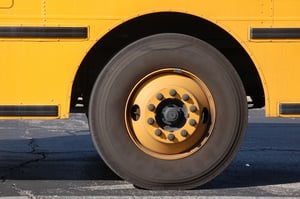Fleet Maintenance: How to Keep Your School Bus Tires Roadworthy
published on June 23, 2016 by Sonia Mastros
school bus safety, fleet maintenance, tire safety
 Each day, school buses transport students around North America to and from school, special programs, field trips and sporting events. Parents and administrators rely on transportation departments to keep students safe, and tire care should be part of any effective fleet maintenance plan.
Each day, school buses transport students around North America to and from school, special programs, field trips and sporting events. Parents and administrators rely on transportation departments to keep students safe, and tire care should be part of any effective fleet maintenance plan.
Worn tires do not grip the road as they should and this poses a serious safety risk, particularly during inclement weather. A tire blowout is not only inconvenient, it exposes the bus and its occupants to hazardous conditions. Safety advocates urge transportation departments to replace tires as soon as they show signs of aging, and each ten years even if they don’t. There are several ways to incorporate tire safety into your fleet maintenance plan.
Choose Tires with Care
Price doesn’t always indicate quality. Just because a tire comes with a hefty price tag doesn’t mean it’s the best option on the market. This doesn’t mean that choosing a budget brand is necessarily the best choice either. Tires should always at least match the ply rating recommended by the manufacturer.
Store Wisely
Storing tires outdoors leaves them exposed to the elements. This means that they can begin to deteriorate before being used. Tires should be stored indoors or under a tarp.
Regularly Check Inflation and Pressure
The air pressure of all tires should be checked and corrected weekly, using an accurate pressure gauge. Tire pressure should be checked on cold rather than hot tires. Using tires that are improperly inflated can lead to significant tire damage.
Check Axle Alignment and Tread Depth
Tires that come into frequent contact with curbs and speed bumps often have axles that are knocked out of place. Fleet maintenance staff should also establish a minimum tread depth allowed before a tire must be changed. This could vary based on road conditions and weather.
Don’t Mix and Match Tire Types and Brands
Each tire type has its own set of characteristics, and mixing brands and types can cause one tire to work harder to compensate, leading to possible blowouts.
Tires are not the only school bus safety feature that should be considered. To discover more about available tools to keep students safe, contact the transportation experts at BusBoss.
How has your district incorporated tire maintenance into its overall fleet maintenance plan? We’d love to hear from you.



